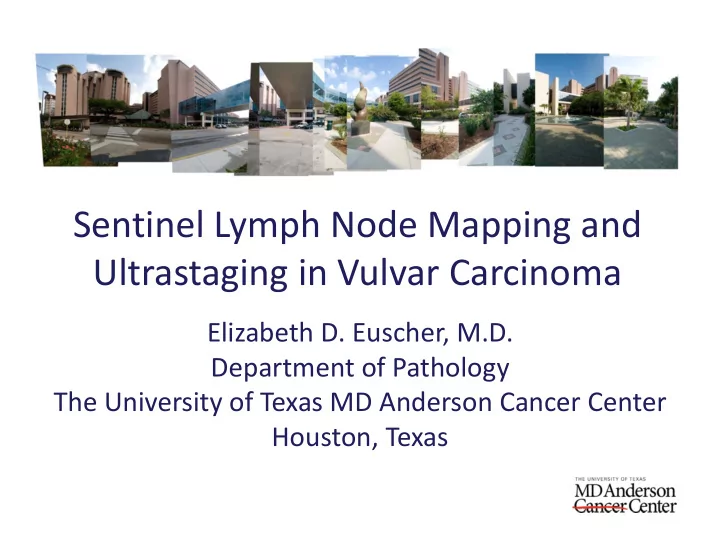

Sentinel Lymph Node Mapping and Ultrastaging in Vulvar Carcinoma Elizabeth D. Euscher, M.D. Department of Pathology The University of Texas MD Anderson Cancer Center Houston, Texas
Vulvar Squamous Cell Carcinoma • 56 year old woman • Long ‐ standing vulvar pruritus • Notes growing mass at introitus • Partial radical vulvectomy with sentinel lymph node biopsy
Sentinel Nodes are Medial
Sentinel lymph node, frozen section Sentinel lymph node, permanent section Sentinel lymph node, level 1 of ultrastaging protocol
Incidence of Vulvar Malignancies Vagina Ovary Melanoma 1% 26% 5 ‐ 10% Other Vulva 1 ‐ 5% 6% Uterus Squamous Cell Cervix 54% Ca 14% 90%
Morbidity of Inguinofemoral Lymph Node Dissection • Nodal status most important prognostic factor • 20 ‐ 30% clinically negative LNs have metastases • Prognostic information obtained with high potential for morbidity in 70 ‐ 80% – 14 ‐ 48% lymphedema – 7 ‐ 40% lymphocele – 21 ‐ 39% wound breakdown Image courtesy of Dr. Charles Levenback
Historical Attempts to Reduce Morbidity • 1979 DiSaia: inguinal lymph nodes above cribriform fascia, “sentinel” – With ( ‐ ) inguinal LN, risk of (+) pelvic or femoral LN low • GOG ‐ 74 (Stehman, et al 1992) – 121 pts: ipsilateral superficial inguinal lymphadenectomy – Fewer complications compared to radical surgery – 7.3% groin recurrence (0% in historical controls)
Modern Sentinel Lymph Node Concept Injection of blue dye or radiocolloid around tumor Sentinel node first site of metastasis Regional nodes Sentinel lymph node Primary tumor
• Superficial site, ease of injection • Fairly predictable lymphatic drainage • Mapping allows detection of aberrant drainage to deep LNs • Feasibility study of 9 patients (12 groins)
Sentinel Lymph Nodes and Vulvar Carcinoma • Most studies identified SLN in >90% of pts • False negative rate 0 ‐ 8.3% • Groin recurrence 2.3% in 259 pts with SLN alone • False negative associated with: – Inexperience – Tumor size >4.0 cm – Midline tumors – Clinically positive lymph nodes
Value of Ultrastaging • Fewer LNs received allows for more thorough, targeted examination than would be practical in a standard dissection • 4 ‐ 23% increase in detection over standard processing • 58% smaller metastases detected
Variability in Ultrastaging Protocols Study Year # Patients Ultrastaging Protocol* False Negative de Hullu 2000 26 3 H&E/mm + pankeratin if H&E ( ‐ ) 0 de Cicco 2000 37 3 H&E’s 0.3 to 1.0 mm into block 0 Sliutz 2002 26 Block cut through 400 μ m intervals H&E + 0 unstained; pankeratin if H&E ( ‐ ) Moore 2003 29 5 H&E’s at 100 μ m intervals 0 Puig ‐ Tintore 2003 26 2 H&E’s + unstained 400 μ m intervals ; CKC if 0 H&E ( ‐ ) Martinez ‐ 2006 27 IHC for pankeratin if initial H&E negative 1/27 Palones Serial sections 40 μ m intervals (every 3 rd slide Rob 2007 59 0 CKC) Vidal ‐ Sicart 2007 70 1H&E + 1 pankeratin 400 μ m into block 0 Hampl 2008 127 Block cut through at 200 μ m intervals H&Es + 3/127 unstained for pankeratin Van der Zee 2008 457 3 H&E/mm + pankeratin if H&E ( ‐ ) N/A Achimus ‐ 2009 59 Block cut through at 200 μ m intervals for 0 Cadariu maximum of 6 H&E Devaja 2011 60 1H&E + pankeratin at 400 μ m intervals; 0 maximum 7 pairs Levenback 2012 418 Pankeratin 40 μ m interval from H&E 11/418 *when initial H&E slide negative
Grossing SLN • Lymph nodes sectioned perpendicular to long axis at 2.0 mm intervals • Entire lymph node submitted for routine processing
SLN for Routine Processing SLN positive SLN negative 5 H&E slides + No further 2 unstained at work up 250 μ m intervals Levels Levels positive negative No further Keratin IHC work up
Scientific Rationale • Meyer, et al (1998) – Modeled the probability of micrometastasis detection for specific sizes in several microsectioning planes – Model of H&E and immunohistochemistry at 250 μ m intervals detected 0.25 mm metastasis with a theoretical probability of 1 and 0.1 mm metastasis with a theoretical probability of 0.46 • Euscher, et al (2008) – 10 SLN with < 2.0 mm foci metastatic squamous cell ca – Model based on median size, 0.9 mm found >95% probability of detection using 5 intervals at 250 μ m
Role of Immunohistochemistry • Levenback, et al 2012 – 23% improved detection – Additional H&E levels not studied • Moore, et al 2003 – Cytokeratin did not detect additional metastases • Other studies using H&E and IHC do not specify how micrometastases were detected
Significance of Low Volume Disease • Experience limited: – Terada, et al: ( ‐ ) SLN subjected to 400 μ m intervals after groin recurrence detected micrometastasis – Tamussino, et al: <1.0 mm metastasis detected by ultrastaging, no completion lymph node dissection; pt recurred – Davaja, et al: 3 pts with a single positive SLN (2 pts <2.0 mm metastases; 1 with isolated tumor cells) and no other risk factors recurred after opting out of groin dissection
Size #SLN(+) groins #SLN(+) groins #non ‐ SLN(+) Non ‐ SLN with groins metastases completion LND (%per groin) Isolated tumor 51 24 1 4.2 cells ≤ 1mm 13 10 1 10 >1 ‐ 2mm 12 9 1 11.1 >2 ‐ 5mm 15 15 2 13.3 >5 ‐ 10mm 16 13 5 38.5 >10mm 9 8 5 62.5 Total 116 79 15 19
Summary • Sentinel lymph node mapping is standard of care for well ‐ selected vulvar carcinoma cases • Metastasis detection improved by ultrastaging • Optimal protocol yet to be established • Significance of low volume disease in the setting of vulvar squamous cell carcinoma still to be determined
Recommend
More recommend